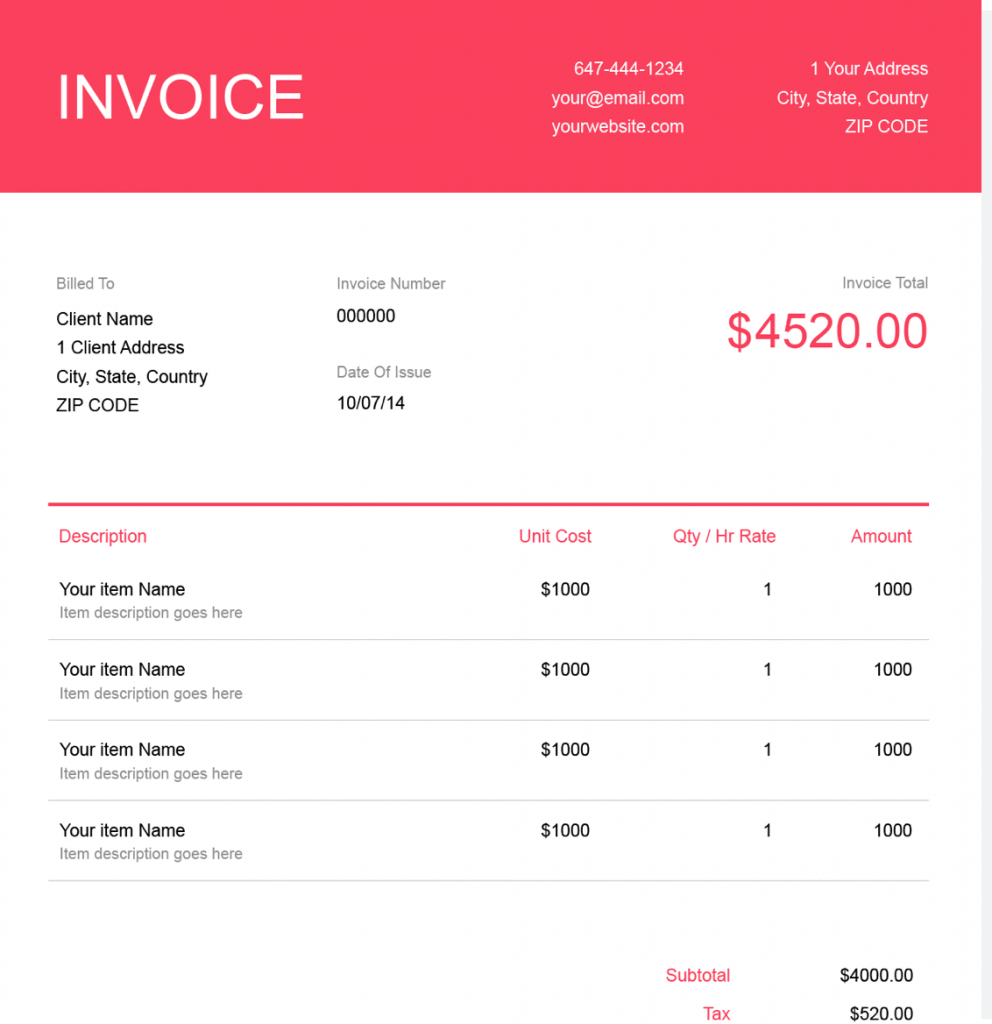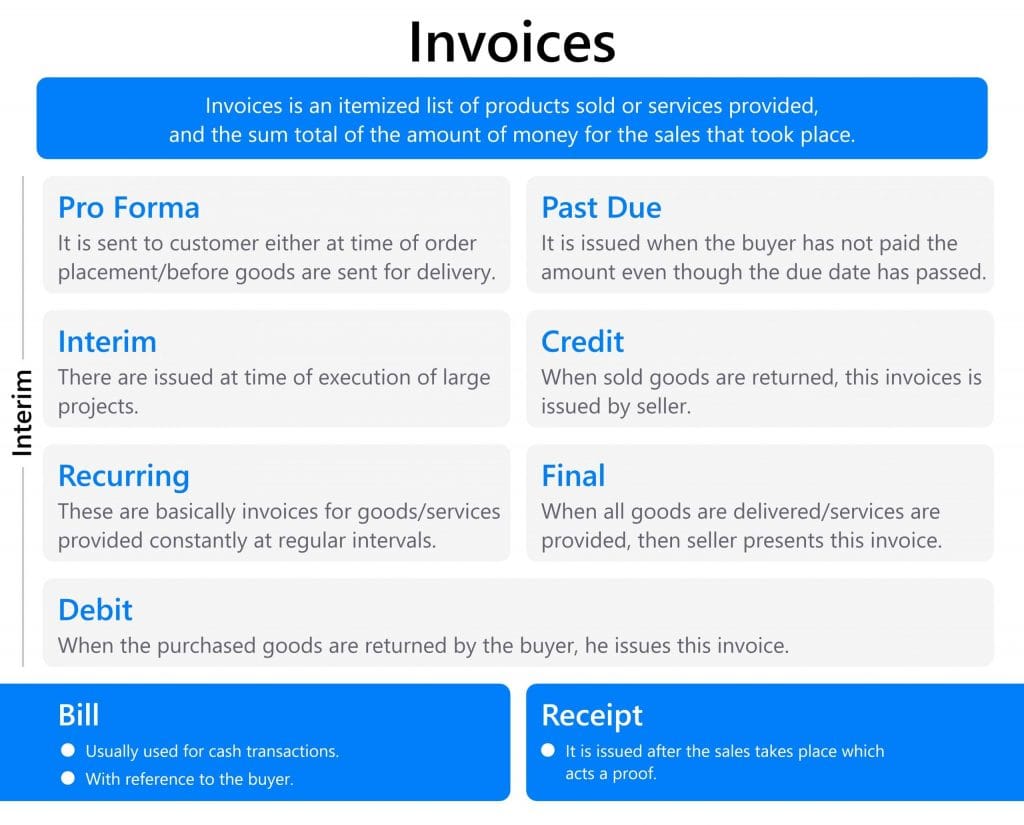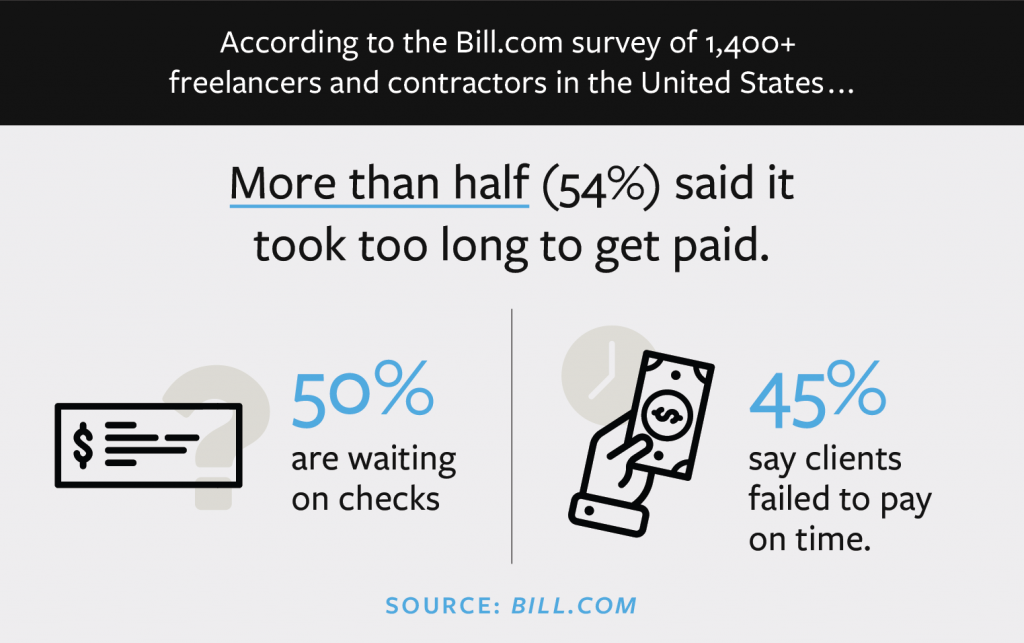How to Fix Invoicing Mistakes as a Freelancer
In the US, almost half of all invoices are overdue. This is an alarming statistic, but it's not always due to businesses not paying on time. In some cases, late payments are due to poor invoicing practices.
If you're a freelancer, creating and sending invoices to your clients is crucial to your operations, no matter your industry. Invoicing enables you to accurately bill your clients and customers for your services, create a paper trail of your past work and payment histories, and forward your payment details and specifications to your clients to ensure you get paid on time.
Invoicing should be a quick and relatively simple process. Unfortunately, many freelancers make common mistakes during invoicing, which can complicate a straightforward exercise and lead to costly and frustrating issues. When you make these invoicing mistakes repeatedly, it can become a burden that impacts your professional reputation and delays prompt payment.
It's essential to maintain regular cash flow as a freelancer. The most effective way to achieve this is by invoicing correctly to ensure you get timeously paid as much as possible. Your clients' abilities to pay you quickly will depend on how accurate, concise and clear your invoices are.
Optimal invoices tell your clients exactly how to act when they receive them and what actions you may take if they are not paid by the specified date.
Poorly written and confusing invoices, on the other hand, can create payment delays by confusing your clients.
This can negatively impact your schedule and cash flow, force you to work longer hours to correct issues, and weaken client relationships.
Read on as we explore some of the freelancers' most common invoicing mistakes. Plus, you'll learn how to optimise your invoices to maintain strong work relationships and robust cash flow all month!
Table of Contents
What is a Freelancing Invoice?

We must understand a freelancing invoice before we delve into invoicing mistakes and best practices.
Freelance invoices are documents used to request timely payment for the services that you have provided. These invoices stipulate the services provided, payment terms, the final amount needed, and how the client can settle the bill.
Freelance businesses differ considerably from larger-scale business contracts, and standard invoices may not suit most freelancers' needs. Web developers, web designers, graphic designers, photographers, writers, musicians, social media managers, and various other freelancers can all use this type of invoice to get paid faster.
The 10 Most Common Freelance Invoicing Mistakes
If you're making any of these mistakes, the chances are you're not getting paid on time.
1: Making It Difficult for Your Clients to Pay You
Your invoices should make it exceptionally easy for your clients to pay you once they receive them. If your clients have to contact you directly to determine your preferred payment methods and details, this can create delays, leading to frustration for your clients and you.
This is why adding your accepted payment methods and details on your invoices is essential to minimise confusion and instruct your clients on how to proceed.
You can consider using intelligent invoicing systems, which enable you to set up numerous payment gateways for your clients to make direct payments via your invoice in just a few clicks. This system is quick, straightforward and free of unnecessary hassles, enabling you to get paid as soon as possible.
2: Omitting Crucial Details

Every invoice you generate must include essential information, often demanded by the state, tax and national laws. Leaving these details off your invoices could make you prone to legal and tax issues later. It may impact the reputation of your brand or business, making you seem unprofessional and impacting your ability to secure clients in the future.
Your invoices should always include the names and addresses of your clients, your name and address, payment details and payment terms, tax numbers, invoice dates and numbers, and the total amount due in the appropriate currency.
3: Failing to Include Detailed Service Descriptions
As a competent freelancer, you probably know exactly which services you have performed for your clients. However, your clients may not unless you describe these services and jobs in detail on your invoices.
Descriptions that are too basic and don't explain the exact nature of your services might confuse your clients and elicit criticism. In some cases, this may lead to an unwillingness to settle an invoice on their part.
Itemising your invoices is the key to avoiding this issue. Break down each project performed into sections and include short summaries of each task you have performed. This will show your clients exactly how much work you've done. As a bonus, it will also enable you to keep more accurate records of your past work and experience.
4: Sending Invoices to the Wrong Addresses
Large organisations often have dedicated billing departments that settle invoices. If you send your invoices to the wrong department or recipient, they can quickly get lost, creating payment delays and the need for multiple reminders.
Double-check the details of your invoice recipients before issuing each invoice, including their name, email address and relevant department.
5: Leaving Due Dates Off
If your invoices don't contain due payment dates, you may wait for weeks or months before the client settles the bill. It's easy for other people and businesses to file your invoices for later payment and forget to do so if there is no payment deadline.
You also won't be able to request late payment fees or enact legal action if you don't include a payment due date in your documentation. Specify in each invoice when the total amount stipulated is due, and make it clear that there could be repercussions, including late payment fees, for delayed payments.
6: Not Distinguishing Between Different Types of Invoices

Many invoices are suitable for freelance work, including standard, progress, deposit, recurring, Pro-forma quotes, and time-billing invoices.
If you don't indicate which type of invoice you are issuing your client, you risk experiencing payment delays and errors. Stipulate the invoice type at the top of each invoice and reinforce it by mentioning it in your payment or terms boxes to minimise confusion.
7: Not Reminding Late-Paying Clients
Many freelancers delay reminding their clients to settle their invoices as they don't want to seem rude or demanding. However, most freelancers can't afford to wait weeks for delayed payments, and some clients will inevitably forget about their invoices. Yet they'll be more than willing to pay immediately when reminded.
Establishing a payment reminder system that automatically sends reminders to your late-paying clients after a certain number of days have passed is recommended. This will automate the process and save you time and effort, allowing you to focus on other tasks until it becomes evident that the client will not pay and you need further action.
8: Sending Out Invoices Late
Most clients expect to receive your invoice when a task, project, or contract ends. If you wait weeks before sending your invoice, you may indicate to your client that invoicing is not your priority. This could make you seem unprofessional and give the impression that you're in no rush to get paid!
Generate your invoices beforehand so they are ready to be sent out as soon as a project has concluded. Additionally, you can create recurring invoices for repeat projects, which will get sent out automatically after the time intervals of your choice.
9: Failing to Focus on Invoice Design

An unattractive, inconsistent invoice design can detract from the quality of your work and your brand's image. Your invoice designs and layouts should always be consistent with the look of your social media accounts, website, business cards, and other freelance documentation to create a coherent brand identity that impresses your clients.
Include the same colour schemes, logos, fonts and other visual elements in your invoice as you have used on your official website and your other brand materials. If your clients look forward to opening your invoices, they will be much more eager to settle them on time.
10: Spending Too Much Time on Invoicing
Creating and sending out invoices shouldn't take hours out of your day. If your invoicing processes overwhelm you, it's essential to streamline them. Choosing the right tools to simplify invoice generation and sending activities is crucial.
Picking reliable invoicing software can simplify invoicing by giving you access to features that allow you to design, generate, and submit invoices in minutes. Ideally, your program of choice should include a range of professional-looking templates, third-party attachment functions, time-tracking tools, secure client portals, and automation features.
Invoicing Best Practices for Freelancers
If you want to avoid the common invoicing problems and mistakes mentioned above, use these best practices. They help you to perfect your invoicing processes and get paid as quickly as possible.
1: Bill Clients Regularly
Many freelancers charge by the hour for their services. If you are one of them, you don't need to wait until the end of a specific project to count your hours and create a single invoice.
Instead, bill every two weeks or every month. This will create a smooth cash flow for your business and break down the total project fee into smaller, more approachable instalments for your clients.
Plus, doing this means that if a client fails to pay for a certain period's work, you can put the project on hold until you receive payment. This will protect you against non-payment.
2: Choose a Specific Day for Invoicing
Invoicing for your billable hours every few weeks helps you to regulate cash flow. It also prevents stressful periods during which you must wait for payments to clear before you can pay your bills.
Some clients pay rapidly, and others have accounting protocols that only allow them to pay you after a month or a few months.
For instance, if your client has a 30-day payment schedule, they should remit payment 30 days after receiving your invoice. If you invoice on Friday, the 14th of the month, your invoice will only become due 30 days later, on a Monday. This would mean that you would need to wait nearly two weeks longer before the client's accountant settles your invoice. So, you'll wait much longer for payment than 30 days.
Invoicing every two weeks on a regular day, like Monday, ensures that operational nuances and delays on your clients' ends have a negligible impact on your cash flow.
It also helps to create consistency in your invoicing schedule. This ensures your bill regularly and never keeps clients waiting too long for the invoices they expect.
3: Research Potential Clients Before Closing Projects

One of the biggest challenges freelancers face today is that some clients will ignore invoices and delay payments for extended periods if they pay at all. It isn't always possible to determine beforehand whether or not a client will default. However, researching before accepting new client projects will help minimise this risk.
A quick Google search on a would-be client may be enough to tell you whether or not they regularly pay and are on time, especially if you check out their websites and social media accounts. You can browse through a few Glassdoor reviews to discover what other experiences freelancers and employees have had with the client and if anyone has dealt with late payment or non-payment issues in the past.
Suppose the potential client doesn't have a website or a strong presence on social media. In that case, you can look for their LinkedIn and other professional platform profiles to seek out connections who can provide references on their behalf. If these references reflect inconsistent payment habits, respectfully decline the project and seek new clients.
4: Request Upfront Deposits and Advance Payments
Requesting upfront deposits from your clients will help you to mitigate the risk of not getting paid. Clients willing to offer advance payments tend to be more committed to projects and are more likely to pay you on time.
You can issue invoices with total job estimates and include an advance payment sum required at the start of the project. Before beginning the project, this advance payment should clear in your bank account.
Many freelancers charge upfront deposits of between 20% and 100% of the total project amount. This amount will depend on the nature of the work, the size of the task, the reputation of the client, and your expertise and reputation in your line of work.
You may encounter some clients who are wary of making advance payments. In these cases, you can offer guarantees on the payment to protect the client should the project get cancelled before you start or complete it.
5: Include Fair Payment Terms
Including fair payment terms in your invoices is critical to your success as a freelancer. You must establish these terms during each project's negotiation stage to ensure no disagreements or misunderstandings later.
Your payment terms should work for you. But they should also be workable for your clients to ensure that all parties involved are satisfied. Include them in your invoice template to always be a reminder to your clients.
This section of your invoice should include the exact nature of the services you are supplying to the client, the payment due date, and terms of early termination, including notice, compensation and more. You should also include guarantees of the quality of your work, your delivery schedules, and a timeline for the completion of the project.
6: Offer a Range of Payment Options

To receive payment quickly for your freelance services, you must provide as many payment options to your client as possible. Some clients prefer making payments online via eWallets or EFT; others prefer sending checks or paying in cash alone.
If you accept all of these methods and more, you can satisfy the needs of every client while getting paid rapidly for completed projects.
Thanks to the wide range of payment technologies available today, it's never simpler for freelancers to offer diverse payment methods to their clients. This becomes even easier with invoicing software that you can integrate with popular payment gateways like Google Pay, RazorPay, and PayPal.
Integrating your invoicing software with various payment gateways will enable your clients to easily make online payments using credit and debit cards, online banking, eWallets and other options. If you offer your clients the most convenient banking method, they will have no excuse to pay you late!
7: Find the Correct Forwarding Details
Many freelancers send invoices directly to the people they work with within a business. This person may not be the one who is in charge of processing or releasing payments. Instead, they'll need to forward the invoice to the correct department. This can delay payment and sometimes cause the invoice to be lost in the ether.
Generally, a company's accountant will handle the invoice validation and payment process. If you want to get paid fast, you need to send your invoice directly to the person responsible for settling your client's invoices—and, of course, you can copy it to other parties if necessary. This is a simple way to slash your payment cycle and keep your cash flow as consistent as possible.
8: Keep Up with Changes Outside the Scope of Your Work
It's essential to bear the terms of your agreements and the scope of work with your clients in mind. Many clients think of extra tasks or work while a project is underway, not realising that it is outside the scope of work discussed or not worth discussing with you. When you bill them for the additional services rendered, this can lead to payment disputes.
Ultimately, it's your responsibility to determine when your work is outside the scope of work outlined in your agreement. Once you've noticed this, immediately inform the client that the work will get billed separately. Remember to inform them of the cost of this extra work.
At this stage, your client will either agree with your terms or request that you stop with the additional work. This will save you from doing additional work and finding out later that your client was not expecting to get charged.
9: Include Incentives and Penalties in Your Invoices

Adding incentives to your invoices can help ensure you get paid quickly, and penalising late-paying clients can have a similar effect. Some freelancers charge a standard interest rate for the whole period that an invoice has been overdue. They include this additional interest charge in their payment reminders to encourage clients to make payments as soon as possible.
You can use early discounting to provide quick-paying clients with discounts and encourage them to pay every invoice before it becomes due. Mention these discounts on your invoice and any other incentives you plan to prompt clients to prioritise your invoices.
10: Create a Follow-Up Protocol
Creating a reliable follow-up process will help ensure you don't miss out on payments. It's crucial to send your clients timely reminders at regular intervals of two weeks to ensure that your invoices are always at the front of their minds.
If you don't receive responses to your emails, consider following up with personal messages or telephone calls that are polite and respectful but firm. Remaining consistent in your communication with clients will help you to elicit payment faster without harming your working relationships.
The Takeaway
Freelancers across industries face various invoicing challenges that can lead to late payments, negatively impact client relationships, and strain their brand images.
Use these invoicing best practices to address freelance invoicing issues and keep the money rolling in.
